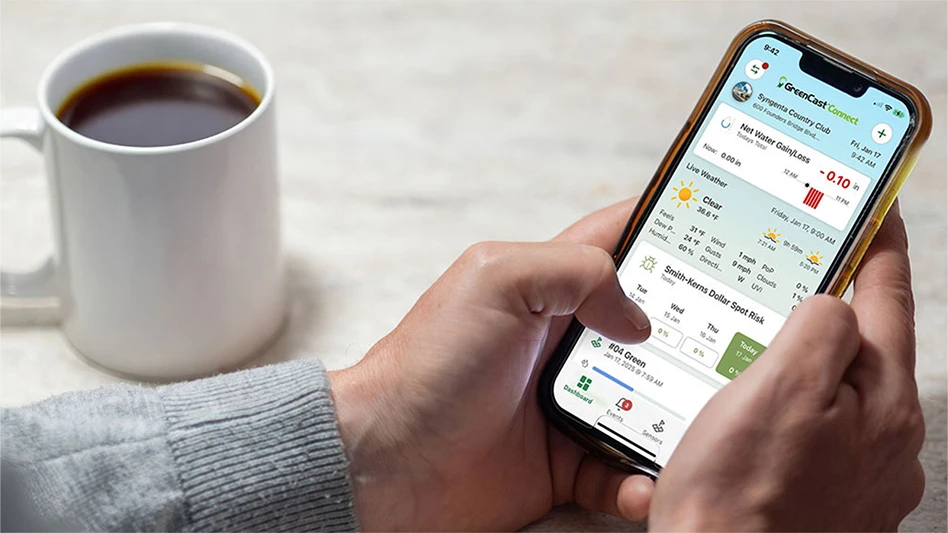Q During the PGA Championship and other summer events, I’ve noticed the grounds crew was hand-watering/syringing greens during play. Is this a normal practice and why?
A Most definitely. The temperatures in Tulsa, Okla., exceeded 100 degrees. The PGA Championship staff allowed the superintendent to syringe and quickly water the greens, which were stressed because of the heat and player/caddie traffic. This is done frequently and coordinated with the on-course rules officials, so not to interfere with the players and the PGA’s pace-of-play system. Turf health is always a priority, even during a major championship.
Q The competitors in the PGA Championship were concerned with excessive spike marks on the putting greens and were vocal about it. What’s the deal?
A The professional tours allow metal spikes to be worn. A player has the option to wear metal spikes or to consider spikeless alternatives. Countless research indicates the alternatives are as stance stable and traction worthy as metal spikes – and far better agronomically.
At this year’s PGA Championship, a combination of metal spikes, high heat, humidity and increased player traffic contributed to the tufting and vertical oriented position of grass blades. A rolling ball will be deflected from its true course to a different direction by the tufted grass blades because of a player’s option not to wear spikeless alternatives.
Ironically, the players are concerned with an issue they create and can rectify.
Q While watching the team of riding mowers cut fairways, I noticed each operator carrying a yellow tennis ball. Why?
A When you have a line of six or more riding mowers cutting in the early morning or late evening hours, it’s difficult to see or hear a fellow operator call out to the operator in front of him if there’s an issue with the forward cutting unit. By having a yellow tennis ball available, the operator who notices an issue, such as a hydraulic leak, low tire air pressure, improper cutting quality or gas leak, can throw the yellow ball up ahead so the line of mowers can immediately stop. They’ll exit and remove themselves from the fairway to avoid any further damage, reel streaking, striping skips or, most importantly, gas and oil leaks.
Q After greens were mowed in the evening, crew members were fixing ball marks created by the day’s play. I noticed they were pouring something into the ball mark after repair. What was in the bottle?
A Each crew member repairing ball marks was adding a sand/bentgrass seed mix back into the ball blemish to begin the healing process. Also, the added sand material helps smooth the surface for a better ball roll for the competitors. The key is to avoid soil or organic matter in the mix in case of a rain event. In that case, any soil in the ball-repair mix, which becomes wet, will streak across the green surface during the mowing process, causing much anxiety to the golf course superintendent and his mechanical staff.
Q Why did the PGA golf course set-up officials stretch tape across the putting surfaces before setting the hole location?
A This is to provide as accurate as possible a front-to-back and side-to-side yardage measurement for the hole location sheets that are given to the competitors and caddies before each formal round of play. The accuracy and distance control the players have is amazing. They require exact yardages for their approach shots into greens.
Also, the PGA Championship staff will place a painted dot on what they will use as their putting surface front-and-back axis along their interpreted line. The players might use these center dots to determine their yardages, or they might create their own measurement methods during practice rounds.
Q Why does the crew spend so much time hand-raking sand bunkers? Wouldn’t it be easier to use a riding, mechanical sand rake?
A It would be easier, on occasion, and usually quicker to maintain a sand hazard with a mechanical rake. However, with rapid raking, slight ridges of sand or tire tracking will remain. Additionally, the swirling of sand might create varying depths within the bunker, especially where the operator enters and exits the hazard.
Any raised sand or ground in a bunker that’s touched by a player’s club during their backswing is a penalty. Although hand-raking is time consuming, it reduces this potential for penalty and creates a smooth, consistent playing surface. Unfortunately, the industry has provided a reduced price for hitting into a hazard because of consistency efforts. A miss-hit that lands into a hazard should be a penalty, not a reward. GCI
Editor’s note: If you have a question about course set-up or maintenance as it relates to golf tournaments or events, e-mail Tim Moraghan at tmoraghan11@comcast.net.
Tim Moraghan is principal of Aspire Golf Consulting in Long Valley, N.J. He can be reached at tmoraghan11@comcast.net or 908-635-7978.
Get curated news on YOUR industry.
Enter your email to receive our newsletters.
Explore the October 2007 Issue
Check out more from this issue and find your next story to read.
Latest from Golf Course Industry
- Turfco introduces riding applicator
- From the publisher’s pen: The golf guilt trip
- Architect Brian Curley breaks ground on new First Tee venue
- Turfco unveils new fairway topdresser and material handler
- Ignite Attachments adds new box plane and grapple
- Mackenzie & Ebert working on new Caribbean course
- Keswick Hall renovating Full Cry course ahead of big year
- The alpha wolf






